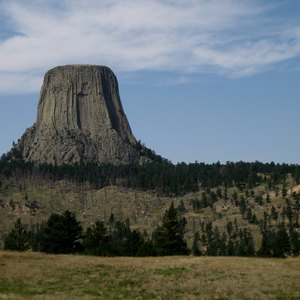
Despite being the 44th state admitted into the Union, Wyoming is also a state of many firsts. It was the first to have a National Forest, with the Shoshone National Forest. Wyoming had the first county public library system with the creation of the Laramie County Public Library System. In fact, Devil's Tower was America's first national monument. For many, buying land in Wyoming is a first as well.
Take Your Time
Buying raw land can be an excellent investment when done correctly. However, the wrong piece of land at the wrong price can be like flushing those investment dollars down the drain. For this reason, it's important that land buyers take their time when considering a land purchase. As the tenth-largest state in land area, Wyoming still has a significant amount of undeveloped land. Therefore, a purchase should rarely be made on the first visit to the property. Raw land in Wyoming is typically a highly sought after real estate investment. A piece of land can be on the market for years. Making an impulsive decision to purchase may lead buyer's remorse once the excitement has worn off. To avoid this, take time to mull the purchase decision over. If for some reason someone else has snatched up that property, chances are there are several more just like it on the market.
Do Your Homework
Not only should buyers take some time to "sleep on" their purchase decision, but do their homework about the property itself. Buyers need to consider what that property is going to be like in all four seasons. In the summertime, that dirt road leading to the property may be perfect, but it may not be in the wintertime when there's several feet of snow on the ground. Lower elevations in Wyoming can receive 70 inches of snowfall annually, with higher elevations can exceed 200 inches of snowfall. Potential property buyers need to consider the easements or right-of-ways that affect the property. In Wyoming, the previous owner may have agreements with cattle ranchers for use of or access through the property that could affect the new owner.
If the buyer is thinking of developing the land in the future, other considerations need to be brought up. Determine whether or not an archaeological survey has been performed. Determine where the nearest utilities are located. Also, find out if there is potable water at a reasonable depth on the land. Wyoming real estate laws do not require the reporting of real estate transactions. Therefore, past sales figures and turn-over rates are typically only available through real estate agents who have privately documented this information. However, because of the non-reporting status of this state, these figures are unverifiable for purchasers.
Location is Still Key
Even if the property is not going to be immediately developed, just like buying a house, the location is still a very important factor. For raw land, a piece of property located close to nearby towns, or popular attractions such as Yellowstone National Park or Jackson Hole, and accessed by a well-maintained road is going to be more expensive than one out in the middle of nowhere that's only accessible by a dirt road that sees more cattle than cars. However, with only a half-million people or so in Wyoming, much of the raw land available is quite remote.
Of course, if remoteness is what the buyer is looking for, this can play in their favor when negotiating a price with the seller. Since most would see the remoteness as a deterrent, the seller should be offering it for a significantly lower price than one less rural. However, if this is a piece of property that the buyer hopes to develop proximity to existing utilities, such as electricity, is a very important factor that has to be taken into consideration when making an offer. Because of the remoteness of much of the raw land in Wyoming, one popular option to counter this location challenge is to live off-grid. Land in the lower elevations of Wyoming is often well-suited to wind energy creation and with the intense summer and winter sunshine this region receives, solar is also an attractive option.
References
Writer Bio
Kimberly Wylie has been a professional, full-time freelance writer for nearly a decade. She is the author of the book "Hiring the Right Candidate" and has written for several online and print publications. A gifted wordsmith, her work has included everything from movie scripts to patent documentation.

